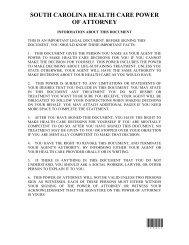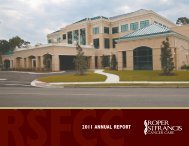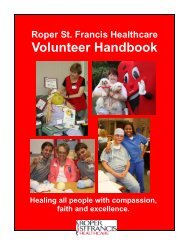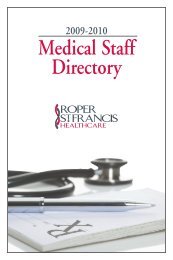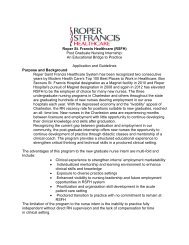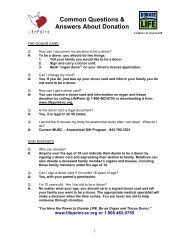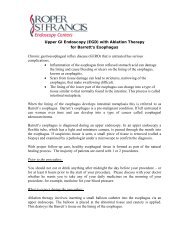Fall 2008, Boost Your Health - Roper St. Francis Healthcare
Fall 2008, Boost Your Health - Roper St. Francis Healthcare
Fall 2008, Boost Your Health - Roper St. Francis Healthcare
You also want an ePaper? Increase the reach of your titles
YUMPU automatically turns print PDFs into web optimized ePapers that Google loves.
Written by Michelle Greenewhat aBellyache!Learning how toread common stomachsymptoms can help youfind both short- andlong-term reliefIt’s a familiar complaint from young and old alike: “My stomach hurts!”Whether you’re a parent trying to figure out what’s wrong with your littleone or you are experiencing inner grumblings of your own, it’s often hardto know what exactly is wrong, much less whether it warrants medication,a trip to the bathroom, or an emergency room visit.Confusion over bellyaches is well warranted, says J. David Bohler, MD, agastrointestinologist affiliated with <strong>Roper</strong> <strong>St</strong>. <strong>Francis</strong> <strong>Health</strong>care, adding that thefirst step is to determine if the pain is in the upper or lower part of the abdomen.Because the stomach is located between the esophagus and the small intestine,your pain could be esophageal (in the tube that runs from throat to stomach),gastric (in the stomach), or digestive (in the intestines). “Talking to the patientto find out where the pain is, what kind of pain it is, what seems to trigger it,and what seems to alleviate it, is critical to making a diagnosis,” Dr. Bohler says.While you should always see a doctor about severe pain, answering thesequestions can help pinpoint the problem. Here, we’ll cover four frequentstomach-related complaints and their most common causes.house calls 35






